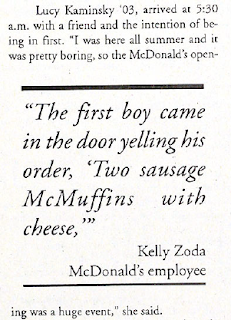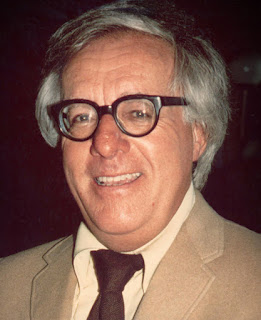Before this victory, however, polio proved to be a potent infection. In 1952 alone, according to official data, more than 60,000 American children were infected and more than 3000 of them died from the disease. In the absence of any effective drugs (prior to the discovery of the polio vaccine), treatment often relied upon iron lungs—a mechanism intended to assist victims whose phrenic nerves had been compromised by the disease. Sometimes constructed to house multiple patients, only the heads and necks of the victims protruding, iron lungs constitute one of the enduring images of an age now happily visible only in America's rear-view mirror.
 |
| 1937 photo of unidentified iron lung facility (http://rarehistoricalphotos.com/children-iron-lung-advent-polio-vaccination-1937/) |
###
Late summer seems to have been the most fertile time for transmission of the polio virus, with announcement of new infections often beginning around Labor Day. In 1952 the first Grinnell case was identified in the August 28 edition of the Grinnell Herald-Register, which reported that Joe Pinder, 20-month-old son of the paper's publishers (Al and Dorothy Pinder), was Grinnell's first polio victim that year. Young Joe was taken immediately to Blank Memorial Hospital in Des Moines where he was described as in "good" condition; within a couple of days he was transferred to a "post-polio ward."The next issue of the newspaper—Labor Day, September 1, 1952—carried news of the town's second case, this time affecting Karla Mae Kingsley, eleven-year-old daughter of Rev. & Mrs. C. E. Kingsley (Rev. Kingsley was pastor of First Baptist Church). Like the young Joe Pinder, Karla was immediately sent to Blank Hospital and confined to the polio isolation ward. The newspaper also carried word of other county residents who had contracted the disease, including two girls from Brooklyn who were sent to Iowa City hospitals.
 |
| Karla Kingsley, 1959 Grinnellian |
 |
| Grinnell Herald-Register, September 11, 1952, p. 1 |
By the middle of September, the Herald-Register had quite a lot of polio news to report. Two more cases in town had been confirmed, both affecting teenagers: Joel Prescott, 13, and Jimmy Urfer, 16. Prescott and his mother went to Blank Memorial while Urfer and his mother went to Iowa Lutheran. The newspaper also reported on a Newton boy who had been diagnosed with polio in Grinnell before being sent to Des Moines.
 |
| Joel Prescott, 1957 Grinnellian |
 |
| James Urfer, 1954 Grinnellian |
Thursday's edition of the Herald-Register had more good news: Joel Prescott, hospitalized a few days earlier, had been released to his parents at home where he was confined to bed for a week and urged to follow doctors' advice to "take it easy." Like Karla Kingsley, Joel was to have "hot baths, exercises and plenty of rest." Jimmy Urfer remained in the isolation ward at Iowa Lutheran, but doctors described his condition as "good." The only down note in this week's report was mention of another new case in Brooklyn: five-year-old Larry Andes was taken to Iowa City because of a polio diagnosis.
The fourth week of the polio outbreak brought news, both good and bad. On the bright side, the newspaper reported that teenager Jimmy Urfer had been moved from the isolation ward at Iowa Lutheran, and was getting along "just fine." Even better, the 19-month-old toddler, Michael Chase, was released from the hospital and sent home. Like others, the little boy was receiving lots of rest and therapy, his grandmother from New Jersey having elected to remain with the Chase family to pick up the slack caused by the death of Michael's mother.
Less happy was the report that Thomas Armstrong, a 26-year-old who was a student at Drake University, had been admitted to the Des Moines Veterans hospital because of polio. According to his parents, the young man's eyes and legs were affected by the disease and he was "quite ill" and kept in the isolation ward.
 |
| Thomas Armstrong, 1944 Grinnellian |
The newspaper's last September issue carried alarming reports of still more cases of infection. A 25-year-old woman—Mrs. Raymond Vogt—who lived on a farm four miles east of Grinnell had been hospitalized several days earlier, but was only diagnosed with polio the day before the newspaper was published. She was sent to Iowa Lutheran on Sunday and immediately installed in the isolation ward. The previous day still another youngster, John O'Connor (six years old), was sent to Iowa City with what doctors described as a "light" case of polio, and was reported to be "feeling fine."
 |
| Gail Vogt (Grinnell Herald Register May 1, 2003) |
Only one new case cast a shadow over the newspaper's October reporting: on October 30 the Herald-Register announced that 15-year-old Eugene Kaisand had been diagnosed with polio and sent to Blank Memorial in Des Moines.
###
The Herald-Register had little else to say about polio beyond the reports of infection. Occasionally the paper provided guidelines for how the public might deal with the virus, but these articles were understandably anodyne; after all, there was no cure for the disease, and the exact means of transmission was not clearly understood. This uncertainty seems to have prompted some to propose that the schools close so as to prevent further spread of the illness, but a September 18 article reported that the city physician, the state board of health, and the superintendent of schools all agreed to keep the schools open. As the city official pointed out, "There is no quarantine prescribed for polio and spraying or fumigation [is] not recommended." The Grinnell school nurse, Mrs. George Coop, who had just taken the job the previous year, was enjoined to study each case and keep "a check on the polio situation." |
| Grinnell Herald-Register August 30, 1951 |
The newspaper also reported on homey efforts to support "the polio fund." One issue told of a "song and dance show" put on by three girls, who ranged in age from 7 to 11; convened on the back porch of the David Johnson house at 935 Spring Street, the event netted $5 from a "free-will offering" that went to the March of Dimes. A few days earlier three other girls charged children a nickel or a penny to attend their "song and dance recital," which also included an acrobatic dancer. Their show gathered $1 for polio.
In other respects, however, the newspaper told of life pursuing its usual courses: parishioners of St. Mary's Catholic church celebrated twenty-five years in their building and bid fond farewell to their priest; Grinnell High School announced cast selections for the autumn production of "Arsenic and Old Lace"; a new cafe opened on State Street; a man was hired to teach typing at the High School; the Herald-Register conducted a contest aimed at increasing subscriptions; the new sewage disposal plant west of town offered tours; and the city water softener went on the blitz.
Against this backdrop of normalcy, the Herald-Register also reported on the visit of Republican presidential candidate, Dwight David Eisenhower, whose whistle-stop campaign brought him to Grinnell early afternoon, September 18. Merchants excitedly prepared and advertised "Welcome, Ike!" specials, intended to capitalize upon the crowds expected for the 15-minute stop in Grinnell. All stores would close from 1 to 2 PM so that everyone could assemble near the tracks on Broad Street when the candidate's train stopped at 1:25 PM.
 |
| Presidential candidate Dwight Eisenhower speaks to a crowd from a train stopped at Broad St. (Grinnell Herald-Register Sep 22, 1952) |
###
Once September had passed, news of polio also passed from the pages of the town newspaper. Next summer would bring more illness, more anxiety, and more news coverage, but until large numbers of children could benefit from the vaccines then still being developed, polio remained a latent threat and unwelcome visitor to town.
For those who in 1952 had come face to face with the virus, however, life was never the same. Those whose cases had been mild and from which they quickly recovered, endured long-lasting, often minor consequences—weakness in a limb, perhaps, or some other reminder of polio. Families whose encounter was more serious had equally serious consequences with which to contend. Mrs. Raymond Vogt, whom I had the pleasure to meet many years after her bout with polio, was left crippled, and confined to a wheelchair for the next several decades. The family of Mrs. Rowland Chase had other battles to fight. Happily, young Michael Chase seems to have recovered from his encounter, but he and his brother lost a mother whom they probably never could recall; their father lost his wife.
Other consequences, less visible but perhaps no less important, accompanied the survivors and their families. Had their friends and neighbors come to help when the dreaded disease appeared, or had fear driven apart friendships formed in easier times? Had school chums shunned those children who had contracted the disease once they had recovered and returned to school? Had high school romances hit the rocks when interrupted by polio's attack?
Answers to none of these questions appear in the public record, so I investigated the oral histories taken from twenty Grinnell seniors in 1992. There was only one mention of polio--a mistake about childhood shots; not even Dr. Parish gave voice to the polio plague and what it meant to Grinnell. Probably for these folk, no less than for the rest of us, introduction of effective vaccines allowed memories of the struggle to disappear. Consequently, sixty-four years after the 1952 polio outbreak, in a time when no one contracts polio here, we can only wonder how Grinnell dealt with the unwelcome visitor.






